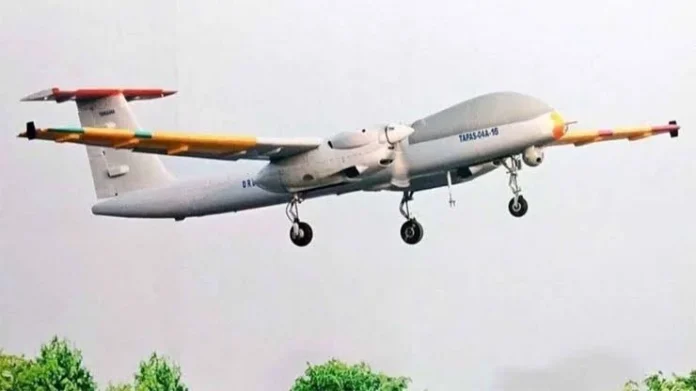New Delhi: The Indian Air Force (IAF) and Navy, in a significant development have decided to incorporate the indigenous ‘Tapas’ drones into their fleets. The decision comes after a series of setbacks, including a crash during testing in Chitradurga, Karnataka, last year. The Air Force plans to request ten Tapas drones from the Ministry of Defence, with six allocated to the Air Force and four to the Navy.
Hoping that continuous improvements by the Defence Research and Development Organisation (DRDO) will enhance its capabilities, both the Air Force and Navy have opted to proceed with the Tapas drone. The Tapas drone, developed by DRDO, will be produced through a joint venture between Hindustan Aeronautics Limited (HAL) and Bharat Electronics Limited (BEL). This collaboration is tasked with completing the delivery of the drones within 24 months of signing the agreement with the Ministry of Defence.
The ‘Tactical Airborne Platform for Air Surveillance,’ or Tapas-BH 201 (Beyond Horizon 201), reflects its intended purpose as ‘Tapas,’ meaning ‘heat’ in Hindi, symbolises the drone’s capability to counter enemy threats. The Aeronautical Development Establishment (ADE) lab in Chitradurga, near Bengaluru, has conducted over 200 tests of the Tapas drone, with the 200th test witnessed by a joint team from the Army, Air Force, and Navy.
Inspired by the American MQ-9 Reaper DRDO started developing the Tapas drone in 2010. The first flight of Tapas took place in 2016. The drone measures 31 feet in length, with a wingspan of 67 feet, and weighs 1800 kg. It can carry a payload of 350 kg and has an endurance of over 24 hours, comparable to the MQ-9 Reaper. Tapas has a combat range of 250 km from its command centre and can fly up to 30,000 feet. However, it falls short of the Predator drone, which can fly up to 40,000-50,000 feet, thus being classified as MALE instead of HALE.
The IAF will deploy the Tapas drones for surveillance along the borders with China and Pakistan, while the Navy will utilise them for monitoring the Indian Ocean. About a year ago, the Navy conducted a sea trial, establishing a command-and-control centre for Tapas on the INS Subhadra warship in the Arabian Sea, 148 kilometres from the Karwar base in Karnataka. The drone successfully flew for three and a half hours at an altitude of 20,000 feet, with 40 minutes of flight controlled from the command centre on the ship. After the trial, Tapas returned to its base in Chitradurga, 250 kilometres away.
The Tapas drone’s capabilities were personally observed by Prime Minister Narendra Modi. In February 2022, during the air show opening ceremony in Bengaluru, a live feed of the flypast was shown to PM Modi via Tapas. Currently, the IAF and Navy use Israeli ‘Heron’ and ‘Searcher’ drones. The Navy and Army have also started receiving ‘Drishti’ (‘Hermes-Starliner’) UAVs, manufactured by Adani Group in collaboration with Israel under the Make in India initiative. Additionally, a deal for 31 MQ-9 Predator (Combat UAVs) drones from the US is in the process of being sealed soon.
The continuous development and eventual deployment of Tapas, despite initial setbacks, highlight India’s commitment to enhancing its indigenous defence capabilities. The inclusion of the Tapas drones in the Indian armed forces marks a significant step towards self-reliance in defence technology.




